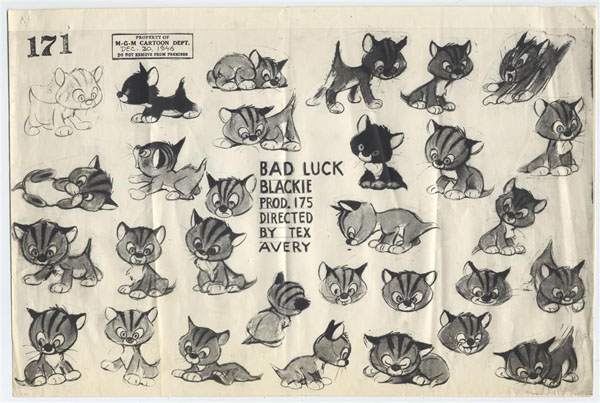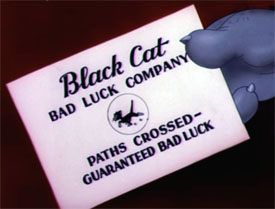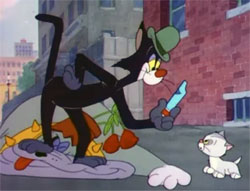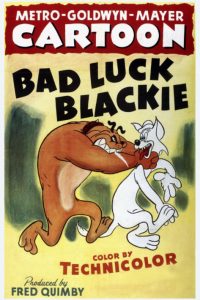
In his book Tex Avery: The Great Animation Director from the Golden Age of the Hollywood Cartoon, author John Canemaker wrote:
“Bad Luck Blackie (January 22nd, 1949) may well be Avery’s masterpiece, a classically structured narrative about superstition and karma that confidently progresses the situation and gags to an inevitable absurd conclusion.”
Many feel the same way. While Tex Avery had a number of cartoon masterpieces, Bad Luck Blackie does indeed stand out as a wonderful example of the director’s exaggerated imagination and genius.
 In Bad Luck Blackie, celebrating its 75th anniversary this year, a cute, little white kitten is being constantly bullied, no make that tormented, by a dog (with a hearty, mean-spirited laugh, provided by Avery himself). The dog’s torments include a mouse trap in a dish of milk and squishing the kitten into the shape of a book. The put-upon kitten is at the end of his rope when he meets a street-smart black cat named Blackie, who asks him, “Hey shorty. Dog trouble?”
In Bad Luck Blackie, celebrating its 75th anniversary this year, a cute, little white kitten is being constantly bullied, no make that tormented, by a dog (with a hearty, mean-spirited laugh, provided by Avery himself). The dog’s torments include a mouse trap in a dish of milk and squishing the kitten into the shape of a book. The put-upon kitten is at the end of his rope when he meets a street-smart black cat named Blackie, who asks him, “Hey shorty. Dog trouble?”
Blackie, with his rakishly tipped bowler hat, appears with a cocky attitude, along with a business card that reads: “Black Cat Bad Luck Company. Paths Crossed-Guaranteed Bad Luck.” The kitten agrees to take on Blackie’s services, and Blackie goes on to demonstrate that he simply crosses the dog’s path, and there is instant bad luck. With that, he crosses in front of the dog as it races after the kitten, and a flowerpot falls on the dog’s head.
 Blackie also gives the kitten a whistle, with instructions to blow it, and the black cat will cross the dog’s path, bringing more bad luck.
Blackie also gives the kitten a whistle, with instructions to blow it, and the black cat will cross the dog’s path, bringing more bad luck.
The dog attempts to continue his bullying ways. The kitten blows the whistle, and Blackie continually crosses the dog’s path (to an instrumental version of “Comin’ Through the Rye” on the soundtrack). Each time Blackie appears, bad luck quite literally falls on the dog in the form of assorted items like pianos, bombs, and cash registers. At one point, the dog attempts to ward off the bad luck with a horseshoe, but after tossing it to the side, he is struck with multiple horseshoes and the horse itself.
Toward the end of the short, luck seems to have come back in the dog’s favor; when he gets a hold of the whistle and paints Blackie white. There’s then a plot twist where the kitten paints himself black and begins enacting bad luck on the dog.
The dog then swallows the whistle, and each time he hiccups and the whistle blows, something new falls from the sky, each one getting hysterically bigger and bigger, growing from a kitchen sink to a battleship. At the finale, the little kitty is crowned with the bowler hat from Blackie and lets out a snicker for the camera.
 Bad Luck Blackie features brilliant animation from Grant Simmons, Walter Clinton, Preston Blair, and Louie Schmitt that not only expands our expectations of animation’s possibilities but, in the midst of the surreal world, gives us distinct personalities. Even through all of the fantastic action, the bulldog is annoyingly despicable, and we genuinely feel for the innocent kitten, particularly in the opening segments.
Bad Luck Blackie features brilliant animation from Grant Simmons, Walter Clinton, Preston Blair, and Louie Schmitt that not only expands our expectations of animation’s possibilities but, in the midst of the surreal world, gives us distinct personalities. Even through all of the fantastic action, the bulldog is annoyingly despicable, and we genuinely feel for the innocent kitten, particularly in the opening segments.
The groundwork for all this was laid by Rich Hogan, who is credited with the story. Hogan was a frequent collaborator with Avery at Warner Bros, with projects such as A Wild Hare (1940) and at MGM with Little Rural Red Riding Hood (1949), among others.
Seventy-five years later, Bad Luck Blackie has earned its spot as a masterpiece and a shining example of a golden age. In 1994, the short was rightfully part of Jerry Beck’s book, The 50 Greatest Cartoons. Bad Luck Black came in at number fifteen.
The short is one of the pinnacles of Tex Avery’s brilliant career. In his book, Of Mice and Magic: A History of American Animated Cartoons, Leonard Maltin sums up what made Avery such an essential member of animation history:
“He is not content to stretch reality for comic effect; He turns it inside out, upside down, and into a fourth dimension that leaves one breathless.”
Below: The opening and closing of the film. To see it complete, it’s on Tex Avery’s Screwball Classics Vol. 1 blu ray – or streaming on MAX.


 Michael Lyons is a freelance writer, specializing in film, television, and pop culture. He is the author of the book, Drawn to Greatness: Disney’s Animation Renaissance, which chronicles the amazing growth at the Disney animation studio in the 1990s. In addition to Animation Scoop and Cartoon Research, he has contributed to Remind Magazine, Cinefantastique, Animation World Network and Disney Magazine. He also writes a blog, Screen Saver: A Retro Review of TV Shows and Movies of Yesteryear and his interviews with a number of animation legends have been featured in several volumes of the books, Walt’s People. You can visit Michael’s web site Words From Lyons at:
Michael Lyons is a freelance writer, specializing in film, television, and pop culture. He is the author of the book, Drawn to Greatness: Disney’s Animation Renaissance, which chronicles the amazing growth at the Disney animation studio in the 1990s. In addition to Animation Scoop and Cartoon Research, he has contributed to Remind Magazine, Cinefantastique, Animation World Network and Disney Magazine. He also writes a blog, Screen Saver: A Retro Review of TV Shows and Movies of Yesteryear and his interviews with a number of animation legends have been featured in several volumes of the books, Walt’s People. You can visit Michael’s web site Words From Lyons at: 






















First of all, visually, MGM cartoons are stunning no matter who is directing! This cartoon is wonderful for its bizarre slapstick timing! Only Fred Avery’s direction could bring things dropping from the sky to surprise you! This is also a kind of departure from original Avery premises for cartoons. In this cartoon, we want to see the cute little cat come out as Victor. Since I like cats to begin with, I like this cartoon very much! Thank you for this post and detailed descriptions of what happens throughout this cartoon. It is yet another great one!
Thank you, Kevin!
“Tex Avery didn’t like my music,” composer Scott Bradley told Michael Barrier late in his life. “We disagreed a lot on what kind of music was appropriate for his cartoons. His ideas on music were so bad that I had to put a stop to it. In every picture he wanted ‘Home Sweet Home’ and all that corny music.” This statement suggests that the use of a familiar old folk song like “Comin’ Through the Rye” as a leitmotif for Blackie must have been all Avery’s idea. We can only be grateful that Bradley didn’t “put a stop to it” on this occasion. Just as Shakespeare’s “Macbeth” is reputedly so unlucky that superstitious actors will only refer to it as “the Scottish play”, it seems appropriate to use a Scottish tune as a metaphor for bad luck. Bradley makes it interesting by continually tweaking the phrasing and orchestration, or by defying our expectations and inserting another song altogether like “Over the Waves”. Thus each iteration of the melody is funnier than the one that preceded it. perfectly matching the sequence of gags
And just to put a cherry on top, at the very end of the cartoon we hear a phrase from “Auld Lang Syne”, another traditional Scottish song whose melody, as it happens, has almost exactly the same sequence of notes as “Comin’ Through the Rye” (though with different rhythm). This ties the whole score together as neatly as the ritornello in a Baroque concerto grosso. No question about it, Scott Bradley was a genius. So was Tex Avery, and “Bad Luck Blackie” is one cartoon where they weren’t working at cross purposes.
Happy birthday, Blackie! Here’s to the cat who’s brought us seventy-five years of bad luck!
Paul, Thank you so much for the information on Scott Bradley. Your knowledge of animation, and much more, is always impressive and I so appreciate your comments! Thanks again!
Thank you, Michael! Fingers crossed for a 50th anniversary Cel-ebration of “Hong Kong Phooey” later this year!
And, of course, Avery’s little bit of voice acting as the mean ol’ dog!
“Bad Luck Blackie”, like “King-Size Canary”, is basically a one-joke cartoon, but Avery and his crew are simply masterful at executing that one joke with new wrinkles and subversions over the course of six minutes, creating a masterpiece out of what would be a tiresome running gag in lesser hands.
Although I have to wonder: was the MGM poster artist really that incompetent all the time, or did they just hate cartoons?
The artist’s name was Bela Rieger, and yes, he really was that incompetent all the time. His poster for “Red Hot Riding Hood” is absolutely hideous.
Which makes it all the more amazing to me that over all those years Harman, Ising, Hanna, Barbera, Avery or any of their animators apparently never went to Quimby and said ‘Hey, this guy is making our work look bad! Why not just let one of us sketch out the posters instead?’
Or maybe they did and were told to just shut up and color?
Tex also had a great laugh, didn’t he?
A classic, no doubt. Joe Adamson’s breakdown of it in his Avery book is a classic.
I just watched the cartoon on MAX. For those who are interested, it is under Tom and Jerry.
I’m a new subscriber to MAX and I must say, most of the cartoons that I’ve watched are DVD-quality restored. Even “Dicky Moe,” which is one of my guilty pleasures.
“For those who are interested, it is under Tom and Jerry.”
Such abuse by the mainstreams it is.
Ivan Pavlov: Dog + bell + food = salivation. Later, dog + bell alone = salivation.
Tex Avery: Dog + whistle + black cat = bad luck. Later, dog + whistle alone = bad luck.
Coincidence or scientific breakthrough?
This cartoon inspired the creation of Marvel’s Spider-Man’s anti-hero, The Black Cat.
I think Tex Avery deserves to be placed among the pantheon of great American filmmakers like John Ford, Howard Hawks, Orson Welles, and Nicholas Ray.
Every time I see this cartoon and see the kitten tormented, I always wish I could go to Roger Rabbit’s Toontown and adopt the little fella.